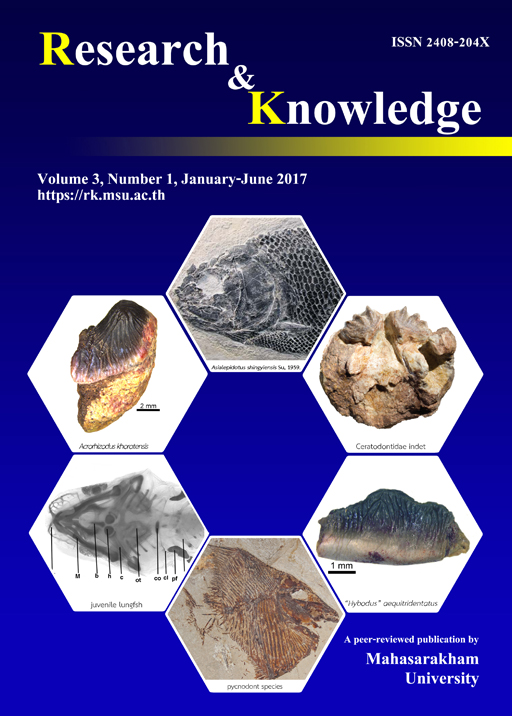The origination and rise of teleost otolith diversity during the Mesozoic
Keywords:
Otolith, macula sacculi, morphological disparityAbstract
The development of an improved hearing sense in teleosts as expressed in fossil otoliths may have been one important element in the success of their evolution. Hence, fossil otoliths add valuable information to paleoichthyology. Teleost otolith morphology, however, has initially diversified very slowly during the Jurassic and Early Cretaceous and accelerated only during major phases of teleost radiation in Late Cretaceous and Paleogene times.
References
Adams, D. C., Otárola-Castillo, E. and Sherratt, E. 2014. Geomorph: software for geometric morphometric analyses. R package version 2.0. (http://CRAN.Rproject.orgpackage=geomorph).
Arratia, G. 2013. Morphology, taxonomy, and phylogeny of Triassic pholidophorid fishes (Actinopterygii, Teleostei). Journal of Vertebrate Paleontology 33, (suppl. 1), 1-138.
Carlström, D. 1963. A crystallographic study of vertebrate otoliths. Biological Bulletin 125 (3), 441-463.
Carnevale, G. and Johnson, G.D. 2015. A Cretaceous cuskeel (Teleostei, Ophidiiformes) from Italy and the Mesozoic diversification of percomorph fishes. Copeia 103 (4), 771-791.
Delsate, D. 1997. Actinoptérygiens du Toarcien inférieur du Grand Duché de Luxembourg: présence de Leptolepis normandica NYBELIN 1962 (Téléostéen) avec otolithes in situ. - Travaux scientifiques du Musée national d’histoire naturelle de Luxembourg 27, 105-129.
Deng, X. H., Wagner, H.-J. and Popper, A. N. 2011. The inner ear and its coupling to the swim bladder in the deep-sea fish Antimora rostrata (Teleostei: Moridae). Deep-Sea Research I 58, 27-37.
Hudspeth, A. J. 1985. The cellular basis of hearing: The biophysics of hair cells. Science 230, 745-752.
Lombarte, A. and Popper, A. N. 2004. Quantitative changes in the otolithic organs of the inner ear during the settlement period in European hake Merluccius merluccius. Marine Ecology Progress Series 267, 233-240.
Nolf, D. 2004. Otolithes des poissons aptiens du Maestrazgo (province de Castellon, Espagne Orientale). Bulletin de l’Institut Royal des Sciences Naturelles de Belgique 74, 101-120.
Nolf, D. 2013. The diversity of fish otoliths, past and present. Royal Belgian Institute of Natural Sciences, pp. 222.
Nolf, D. 2016. Otoliths of Cenomanian fishes in the Ballon Marl (France), the earliest fossil record of perciform fishes. Bulletin d’information des Géologues du Bassin de Paris 53, 14-20.
Patterson, C. 1993. Osteichthyes: Teleostei. In: Benton, M. J. (Ed.), The fossil record 2. Chapman & Hall, 621- 656.
Platt, C. and Popper, A. N. 1981. Fine structure and function of the ear. In: Tavolga, W. N., Popper, A. N. & Fay, R. R. (Eds.), Hearing and Sound Communication in Fishes. Springer, New York, 3-38.
Popper, A. N and Coombs, S. 1982. The morphology and evolution of the ear in Acanthopterygian fishes. American Zoologist 22, 311-328.
Schulz-Mirbach, T. and Ladich, F. 2016. Diversity of inner ears in fishes: Possible contribution towards hearing improvements and evolutionary considerations. In: Sisneros, J. A.(Ed.), Fish Hearing and Bioacustics. Advances in Experimental Medicine and Biology, 341-391.
Schwarzhans, W. 1978. Otolith-morphology and its usage for higher systematical units, with special reference to the Myctophiformes s.l. Mededelingen van de Werkgroep voor Tertiaire en Kwartaire Geologie 15, 167-185.
Schwarzhans, W. 2010. Otolithen aus den Gerhartsreiter Schichten (Oberkreide, Maastricht) des Gerhartsreiter Grabens (Oberbayern). Palaeo Ichthyologica 4, pp.100.
Schwarzhans, W. 2012. Fish otoliths from the Paleocene of Bavaria (Kressenberg) and Austria (Kroisbach and Oiching-Graben). Palaeo Ichthyologica 12, pp. 88.
Tuset,V. M., Farré, M., Otero-Ferrer, J. L., Vilar, J. A., Morales-Nin, B. and Lombarte, A. 2016. Testing otolith morphology for measuring marine fish biodiversity. Marine and Freshwater Research 67, 1037-1048.
Downloads
Published
How to Cite
Issue
Section
License

This work is licensed under a Creative Commons Attribution-NoDerivatives 4.0 International License.








